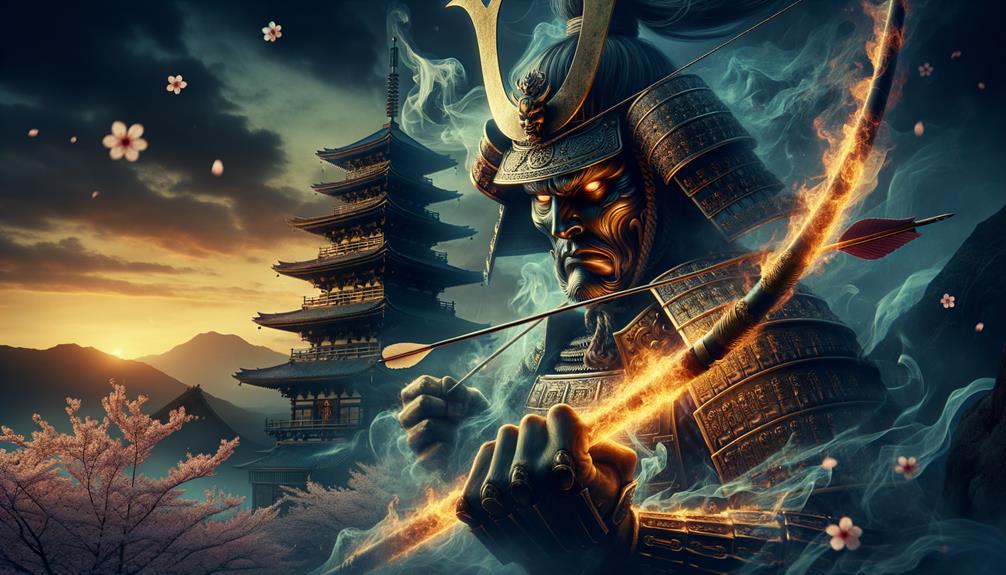You might dismiss Hachiman's legends as outdated tales, but they reveal deep cultural insights into Japan. As a deity bridging Shinto and Buddhist faiths, Hachiman evolved from an Imperial family guardian to a symbol of samurai ideals like perseverance during crises like the Mongol invasions. His journey weaves martial valor with spiritual protection, crafting a rich narrative still shaping modern Japan. How did Hachiman come to personify such enduring values?
Origins and Mythology
Hachiman, initially worshipped as the god of archery and the Imperial family's guardian, personifies the warrior-protector archetype deeply rooted in Japanese mythology. From the outset, Hachiman's legend intertwined with Emperor Ojin and Empress Jingu, mirroring both warfare and the Heian Period's blossoming culture. As Japan's god of archery and war, his role as a protector solidified his prominence.
During the Nara Period, Hachiman's dual identity in Shinto and Buddhism surfaced, especially through the Daibutsu oracle, highlighting his adaptability and profound cultural impact. His interchangeable identity with Emperor Ojin further cemented his position in legendary tales, blending historical and mythological narratives.
The powerful samurai Minamoto clan deeply revered Hachiman as their patron deity. Figures like Yoriyoshi and Yoshiie embodied the clan's martial prowess and divine protection under Hachiman's aegis. Through these connections, Hachiman's legacy as an Imperial protector and a symbol of war and culture endured, forever woven into Japanese mythology's fabric.
The Kamikaze Legends
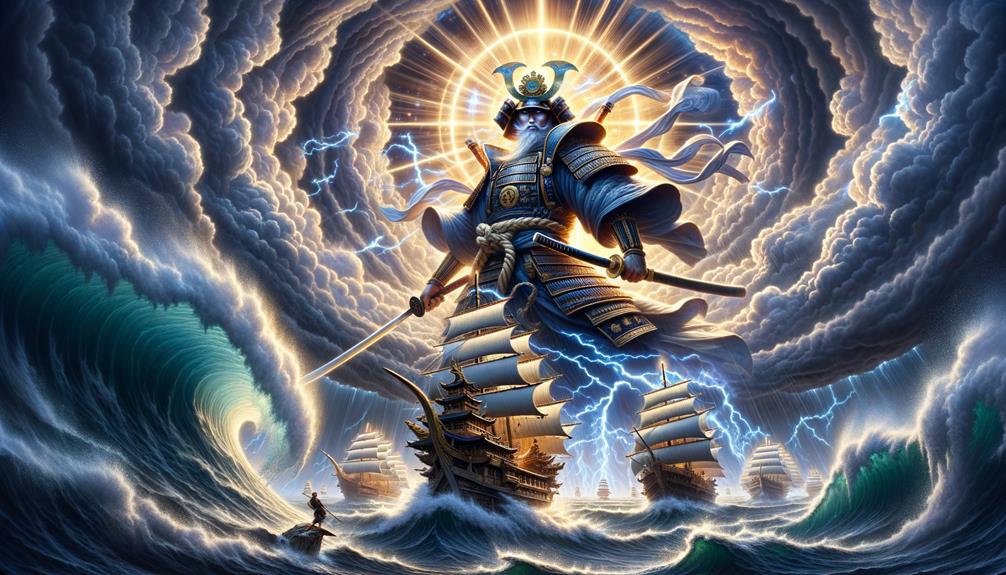
Japan faced imminent Mongol invasions in the late 13th century, yet legends of divine kamikaze winds protecting the nation emerged. The formidable Mongol fleets seemed unstoppable until devastating storms, believed to be summoned by deities like Hachiman (god of war), Raijin (thunder), Fūjin (wind), and Ryūjin (sea dragon), destroyed the invaders in 1274 and 1281.
These kamikaze myths symbolize Japan overcoming overwhelming odds through divine intervention, resonating deeply within the cultural psyche. They highlight Hachiman's role as the nation's steadfast protector during crises. Rather than mere weather events, the legends represent Japan's heroic journey, aided by celestial forces vanquishing existential threats.
The enduring kamikaze narratives underscore an innate belief in spiritual guardianship, with Hachiman's pivotal role reinforcing the idea of divine favor safeguarding Japan throughout adversity.
Hachiman and the Samurai
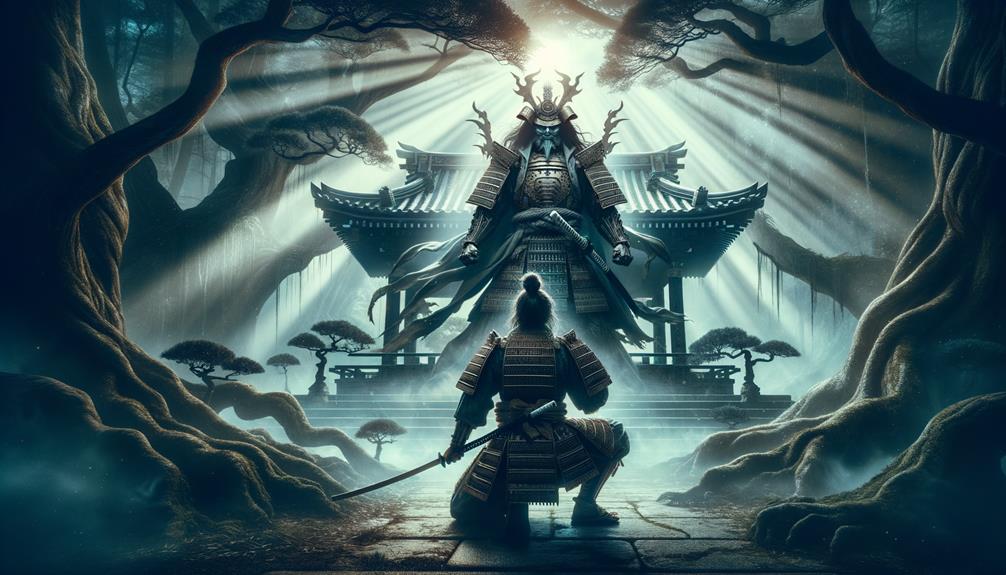
When pondering Hachiman and the samurai, visions arise of a divine figure guiding fierce warriors through epic battles. Hachiman's influence transcended mere combat, offering spiritual direction and embodying the ideal of the wise guardian. The samurai, notably the Minamoto clan, revered him as a wellspring of fortitude and destiny, forever linking their fates to his sacred might.
Protector of Warriors
Japan's warrior culture revered Hachiman, the Shinto deity of war, as the divine protector of samurai. Minamoto no Yoshiie, a renowned warrior from the Minamoto clan, embraced this connection by adopting the name Hachimantaro, signifying his favored status under the god of battle.
Shrines dedicated to Hachiman featured stirrups, bows, and other symbols of warfare, reinforcing his association with military might. During the Kamakura shogunate era, the worship of Hachiman peaked, cementing his role as the guardian of warriors within Japanese martial tradition.
The samurai viewed themselves not just as fighters but as upholders of courage and honor – virtues sanctified by Hachiman's divine patronage. This sacred bond elevated their battles to mythic quests, infusing their military campaigns with profound spiritual significance. Hachiman thus became an enduring emblem of the warrior's journey, encompassing both the martial and spiritual realms of their lives.
Divine Guidance in Battle
Samurai warriors often consulted Hachiman's oracles before battle, seeking divine guidance to secure triumph and honor. The legendary Minamoto clan revered Hachiman as their protector, believing his influence could shape their fate. These warriors stood on the precipice, keenly aware of destiny's weight, and sought wisdom through sacred rituals and prophecies.
Hachiman's guidance was more than spiritual solace; it was integral to the samurai's martial journey. The oracles bridged the earthly and divine realms, offering invaluable insights into challenges ahead. This connection solidified Hachiman's role as the guardian of warriors, whose blessings could turn the tides.
Relics found in Hachiman's shrines embodied this sacred bond. To the samurai, possessing these artifacts imbued them with Hachiman's strength and favor. In battle's crucible, their reliance on Hachiman's guidance and protection wasn't mere superstition but a profound aspect of their martial ethos.
Shinto and Buddhist Worship
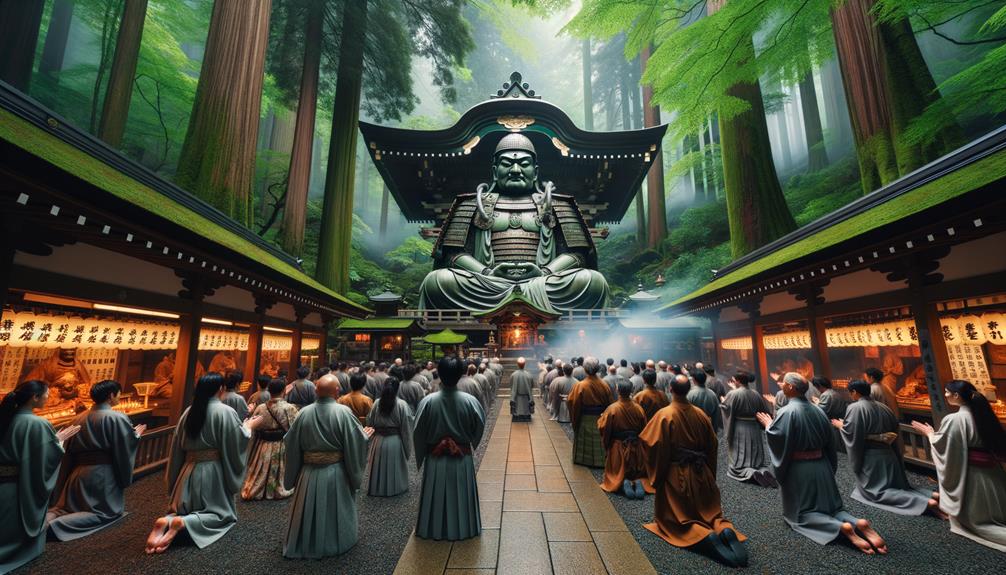
Hachiman effortlessly combines the beliefs of Shinto and Buddhism – this deity embodies a guardian spirit that preserves both our physical world and inner spirituality. Visiting a Hachiman shrine reveals the harmonious mingling of these faiths, a cultural tapestry celebrating unity and enlightenment. This fusion shapes Hachiman as a multidimensional champion safeguarding all aspects of life.
Shinto-Buddhist Syncretism
Hachiman worship exemplifies Japan's unique fusion of Shinto indigenous beliefs and Buddhist practices. This intermingling reflects the country's diverse cultural exchange over centuries. Hachiman, originally a Shinto deity, evolved into a Buddhist bodhisattva, seamlessly blending both traditions.
Male Buddhist priests play a key role in this merger by interpreting Hachiman's oracles, integrating Shinto rituals and Buddhist practices. This spiritual crossover underscores the harmonious coexistence of the two faiths. Hachiman's dual role as a protector and symbol of prosperity highlights how Shinto and Buddhist values have intertwined to enrich worship.
Hachiman's syncretic veneration showcases Japan's profound cultural and spiritual symbiosis, which continues to shape the nation's collective consciousness. This religious intermingling exemplifies Japan's ability to adapt and embrace diverse influences while preserving its unique identity.
Hachiman Shrines Overview
Hachiman shrines personify Japan's warrior spirit, merging Shinto and Buddhist practices into hallowed spaces. These shrines pay homage to Hachiman, the deity of war, representing prosperity achieved through military might. Hachiman, often revered as Emperor Ōjin's divine embodiment, reflects the archetypal hero's journey, guiding warriors and emperors through historical and spiritual battles.
The shrines' dual dedication to Shinto and Buddhism unveils the syncretic nature of Japanese spirituality. This synthesis transcends history, enduring as a living tradition witnessed in rituals and architecture across over half of Japan's registered Shinto shrines. From the Nara period until today, Hachiman shrines stand as tangible reminders of Japan's profound reverence for the warrior deity and its rich cultural heritage.
| Feature | Description |
|---|---|
| Deity Honored | Hachiman – god of war |
| Historical Roots | Traces back to the Nara period |
| Syncretic Practices | Unites Shinto and Buddhist traditions |
| Cultural Significance | Over half of registered Shinto shrines honor Hachiman |
| Archetypal Role | Represents the warrior spirit and prosperity through warfare |
In Japan's mythological tapestry, Hachiman shrines manifest the warrior ethos, bridging the divine and the mortal realms.
Cultural Influence
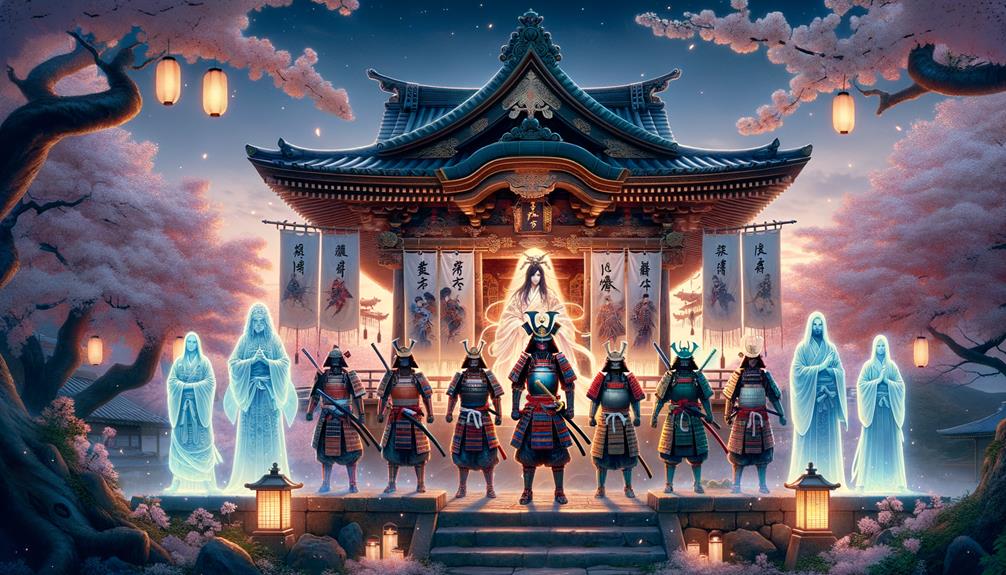
Hachiman's spiritual influence seamlessly blends Shinto and Buddhist traditions, reflecting Japan's martial valor and protective spirituality. With thousands of shrines dedicated to him nationwide, Hachiman's presence pervades daily life. Buddhist temples depict him as a guardian, exemplifying his adaptability and reverence.
As the patron deity of the Minamoto clan, Hachiman personifies military might and prosperity. The Kamakura shrine immortalizes his legend as the Imperial family's protector, praised for safeguarding Japan against Mongol invasions. His divine winds symbolize an enduring commitment to national survival.
Through martial prowess, spiritual guardianship, and defense against foreign threats, Hachiman's cultural significance weaves an everlasting tapestry of honor within Japan's history.
Modern Reverence
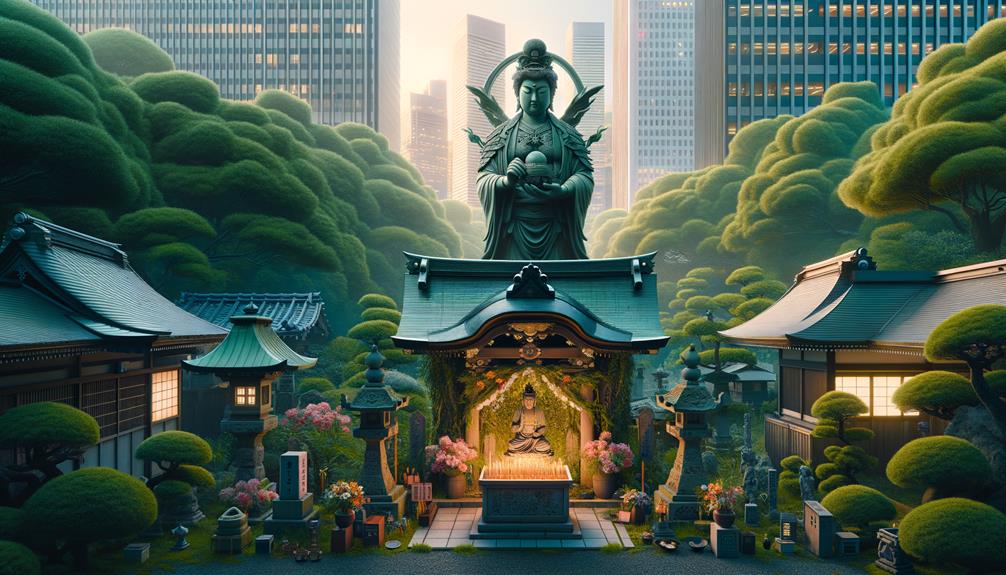
From ancient battlegrounds to modern city streets, Hachiman's legacy persists as contemporary Japan honors him through numerous shrines, celebrations, and customs. As the divine warrior and protector, Hachiman maintains a tangible presence in Japanese society. His shrines stand as testaments to the reverence he commands, not relics of the past but vibrant centers of worship reflecting his enduring cultural significance.
Festivals venerating Hachiman seamlessly blend age-old beliefs with contemporary practices, uniting communities in a harmonious celebration of the old and new. Through rituals and ceremonies, he is invoked as an emblem of fortitude and safeguarding, ensuring prosperity for his devotees.
In modern Japan, Hachiman's archetypal role as the heroic guardian still resonates deeply. His narrative, akin to the hero's journey, presents a timeless tale of valor and resilience. Honoring him today reaffirms the virtues of strength and protection that remain integral to the collective identity.
Frequently Asked Questions
What God Is Hachiman?
Hachiman, worshipped at over 30,000 shrines across Japan, symbolizes the warrior spirit. As the deity associated with archery and military prowess, he represents protection and triumph, guiding heroes on journeys to earn honor and prosperity.
What Are the Powers of Hachiman in Mythology?
According to Japanese folklore, Hachiman wields impressive strength in battle. He commands divine winds, ensuring warriors achieve victory. Beyond the battlefield, he promotes unity and safeguards prosperity among the people. Embodying themes of national defense and protection, Hachiman guides and inspires those devoted to him.
Is It Bishamonten or Hachiman?
Bishamonten and Hachiman hold distinct roles in Japanese folklore. Bishamonten symbolizes wealth and safety, while Hachiman represents warriors and farmers. Their legends highlight contrasting yet vital cultural values.
What Does Yahata No Kami Mean?
Yahata no Kami represents a revered protector deity in Japan, embodying martial skill and safeguarding the nation. This archetypal guardian guides heroes through battles and defense, a symbol of prowess during conflicts. The concept evokes an unwavering force accompanying warriors on their journeys, ensuring their security amidst challenges.

